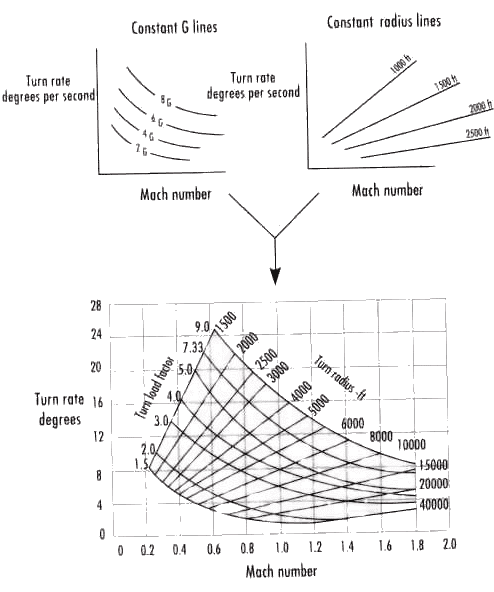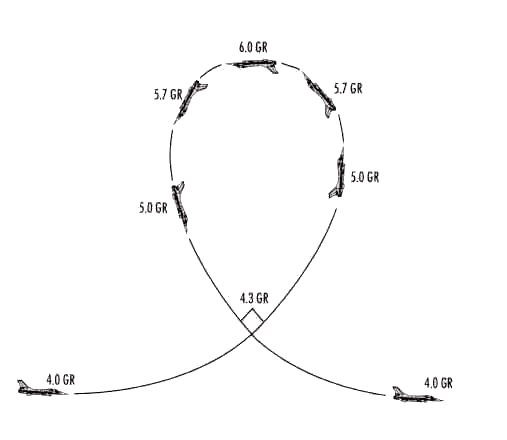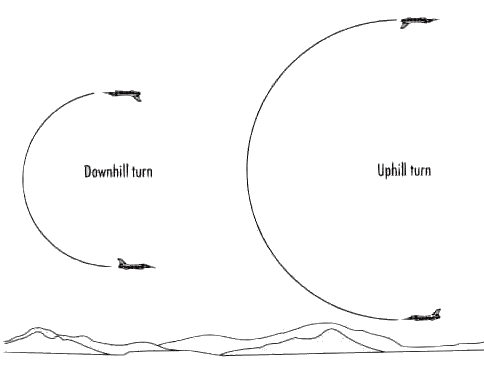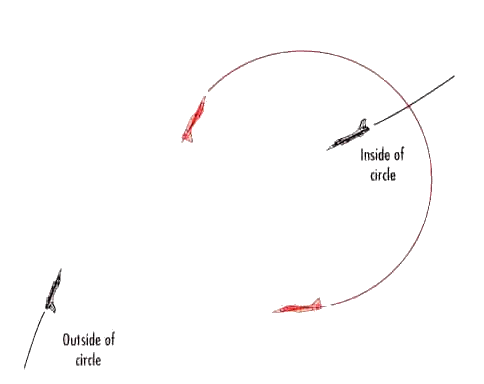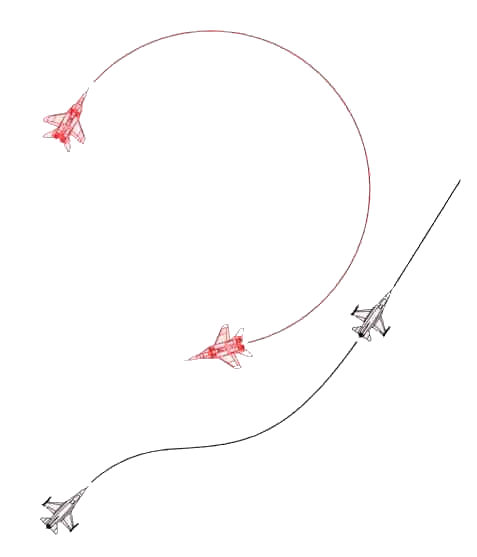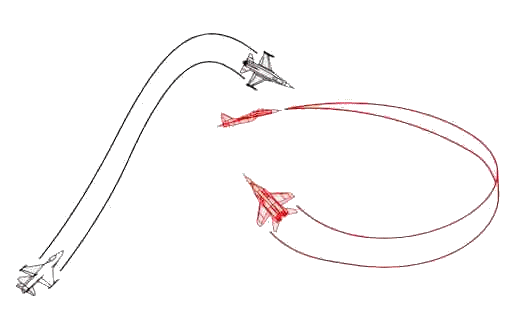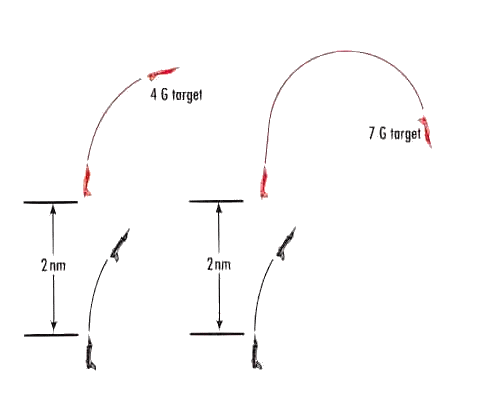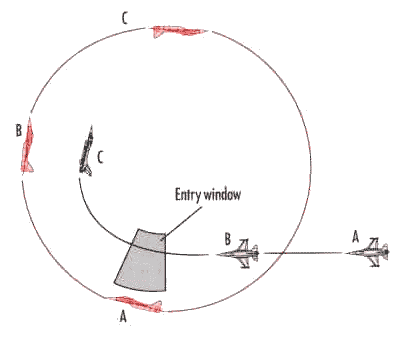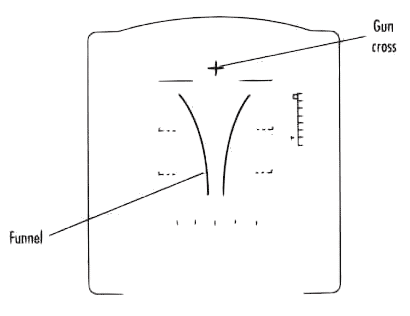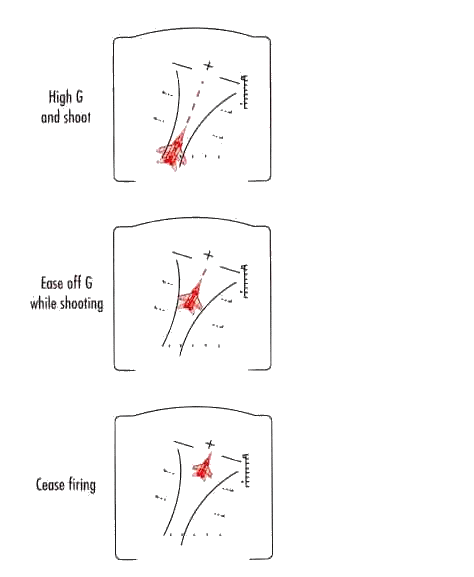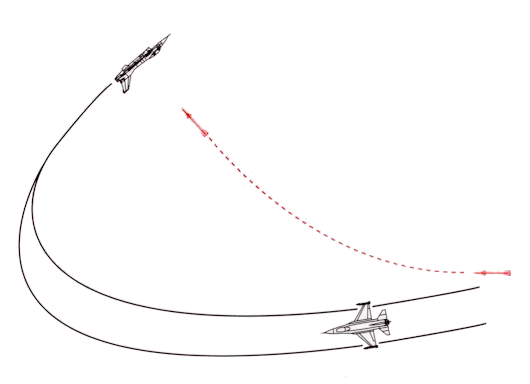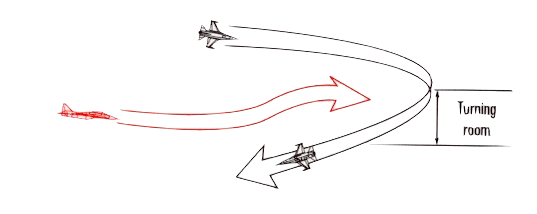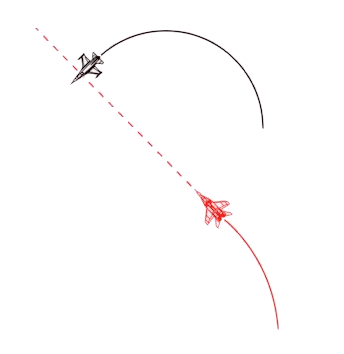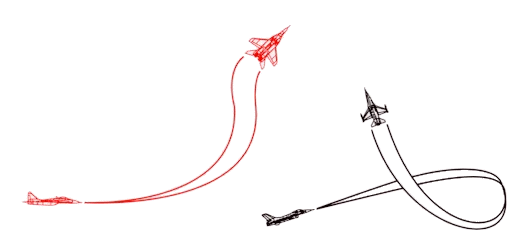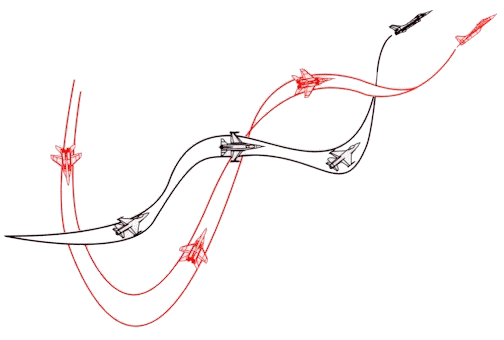Manticore
RETIRED MOD

- Joined
- Jan 18, 2009
- Messages
- 10,115
- Reaction score
- 114
- Country
- Location
The Weapons Envelope
The weapons envelope is the area around the bandit where your missiles or gun can be effective. The weapons envelope is defined by angle-off, range and aspect angle. The dimensions and position of this area are dictated by the type of weapons you are carrying.
If your jet is loaded with all-aspect AIM-9M's or AIM-120's missiles, the area around the bandit looks like a doughnut; the outside ring being maximum range (Rmax) and the inside ring being minimum range (Rmin). With each missile, Rmax and Rmin are different. Generally speaking, missiles that have a greater range or Rmax also have a greater minimum range or Rmin.
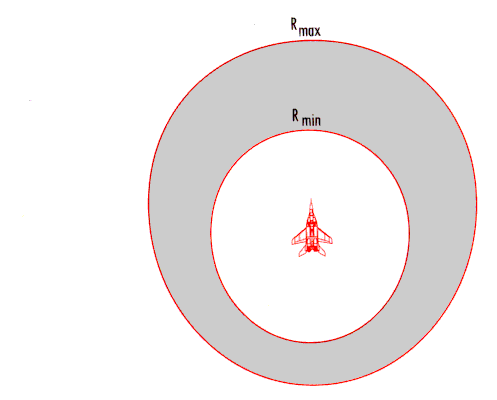
Notice the oval shape of the all-aspect missile envelope. More of the area is in front of the bandit than behind him because a missile fired at high aspect on a bandit (that is, from in front), has a greater effective range than a missile fired at low-aspect (from behind). If you shoot a missile head-on at a bandit, the mere fact that the bandit is flying towards you will help the missile reach its target. The missile may actually fly a shorter distance to hit the bandit head-on than if it were fired at the bandit's six. However, the range at which you first launch the missile will be greater, and this is what is important. The farther away you can launch a missile on the bandit and still have that missile be effective, the better. Always strive to get maximum performance out of your weapons. Another way to increase a missile's effective range is to launch at a significantly higher altitude than the bandit. This will give your missile a reserve of potential energy that it can convert into kinetic energy.
As a target pulls G's, the weapons envelope shifts. Generally, the limits of Rmax and Rmin in front of the aircraft both move out in the direction of the turn, while Rmax and Rmin behind the aircraft move in on the belly side of turn. The next image shows a target in a 5 G turn. The important point to remember is that a bandit that is in fear of dying will turn into you at high G. When this happens, Rmin expands outward from the target at a rapid rate, and within seconds you may be inside minimum range for a missile shot.
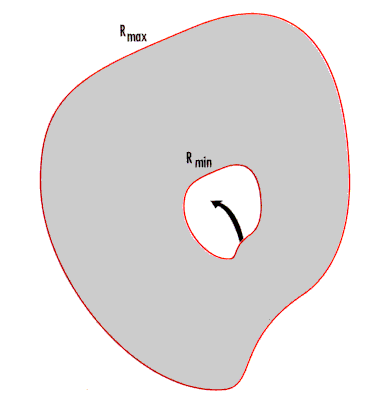
For Guns
The gun is different from missiles in that it has no minimum range. The gun weapons envelope is a circle around the bandit depicting the gun's maximum range. There is no minimum range circle.
Remember, a fighter pilot must be aware of where he is at all times in respect to his weapons envelope.
The geometry of the fight is important. You should understand the principles and terms covered on this page in order to become a good pilot.
---------- Post added at 09:24 AM ---------- Previous post was at 09:24 AM ----------
The Weapons Envelope
The weapons envelope is the area around the bandit where your missiles or gun can be effective. The weapons envelope is defined by angle-off, range and aspect angle. The dimensions and position of this area are dictated by the type of weapons you are carrying.
If your jet is loaded with all-aspect AIM-9M's or AIM-120's missiles, the area around the bandit looks like a doughnut; the outside ring being maximum range (Rmax) and the inside ring being minimum range (Rmin). With each missile, Rmax and Rmin are different. Generally speaking, missiles that have a greater range or Rmax also have a greater minimum range or Rmin.

Notice the oval shape of the all-aspect missile envelope. More of the area is in front of the bandit than behind him because a missile fired at high aspect on a bandit (that is, from in front), has a greater effective range than a missile fired at low-aspect (from behind). If you shoot a missile head-on at a bandit, the mere fact that the bandit is flying towards you will help the missile reach its target. The missile may actually fly a shorter distance to hit the bandit head-on than if it were fired at the bandit's six. However, the range at which you first launch the missile will be greater, and this is what is important. The farther away you can launch a missile on the bandit and still have that missile be effective, the better. Always strive to get maximum performance out of your weapons. Another way to increase a missile's effective range is to launch at a significantly higher altitude than the bandit. This will give your missile a reserve of potential energy that it can convert into kinetic energy.
As a target pulls G's, the weapons envelope shifts. Generally, the limits of Rmax and Rmin in front of the aircraft both move out in the direction of the turn, while Rmax and Rmin behind the aircraft move in on the belly side of turn. The next image shows a target in a 5 G turn. The important point to remember is that a bandit that is in fear of dying will turn into you at high G. When this happens, Rmin expands outward from the target at a rapid rate, and within seconds you may be inside minimum range for a missile shot.

For Guns
The gun is different from missiles in that it has no minimum range. The gun weapons envelope is a circle around the bandit depicting the gun's maximum range. There is no minimum range circle.
Remember, a fighter pilot must be aware of where he is at all times in respect to his weapons envelope.
The geometry of the fight is important. You should understand the principles and terms covered on this page in order to become a good pilot.
The weapons envelope is the area around the bandit where your missiles or gun can be effective. The weapons envelope is defined by angle-off, range and aspect angle. The dimensions and position of this area are dictated by the type of weapons you are carrying.
If your jet is loaded with all-aspect AIM-9M's or AIM-120's missiles, the area around the bandit looks like a doughnut; the outside ring being maximum range (Rmax) and the inside ring being minimum range (Rmin). With each missile, Rmax and Rmin are different. Generally speaking, missiles that have a greater range or Rmax also have a greater minimum range or Rmin.

Notice the oval shape of the all-aspect missile envelope. More of the area is in front of the bandit than behind him because a missile fired at high aspect on a bandit (that is, from in front), has a greater effective range than a missile fired at low-aspect (from behind). If you shoot a missile head-on at a bandit, the mere fact that the bandit is flying towards you will help the missile reach its target. The missile may actually fly a shorter distance to hit the bandit head-on than if it were fired at the bandit's six. However, the range at which you first launch the missile will be greater, and this is what is important. The farther away you can launch a missile on the bandit and still have that missile be effective, the better. Always strive to get maximum performance out of your weapons. Another way to increase a missile's effective range is to launch at a significantly higher altitude than the bandit. This will give your missile a reserve of potential energy that it can convert into kinetic energy.
As a target pulls G's, the weapons envelope shifts. Generally, the limits of Rmax and Rmin in front of the aircraft both move out in the direction of the turn, while Rmax and Rmin behind the aircraft move in on the belly side of turn. The next image shows a target in a 5 G turn. The important point to remember is that a bandit that is in fear of dying will turn into you at high G. When this happens, Rmin expands outward from the target at a rapid rate, and within seconds you may be inside minimum range for a missile shot.

For Guns
The gun is different from missiles in that it has no minimum range. The gun weapons envelope is a circle around the bandit depicting the gun's maximum range. There is no minimum range circle.
Remember, a fighter pilot must be aware of where he is at all times in respect to his weapons envelope.
The geometry of the fight is important. You should understand the principles and terms covered on this page in order to become a good pilot.
---------- Post added at 09:24 AM ---------- Previous post was at 09:24 AM ----------
The Weapons Envelope
The weapons envelope is the area around the bandit where your missiles or gun can be effective. The weapons envelope is defined by angle-off, range and aspect angle. The dimensions and position of this area are dictated by the type of weapons you are carrying.
If your jet is loaded with all-aspect AIM-9M's or AIM-120's missiles, the area around the bandit looks like a doughnut; the outside ring being maximum range (Rmax) and the inside ring being minimum range (Rmin). With each missile, Rmax and Rmin are different. Generally speaking, missiles that have a greater range or Rmax also have a greater minimum range or Rmin.

Notice the oval shape of the all-aspect missile envelope. More of the area is in front of the bandit than behind him because a missile fired at high aspect on a bandit (that is, from in front), has a greater effective range than a missile fired at low-aspect (from behind). If you shoot a missile head-on at a bandit, the mere fact that the bandit is flying towards you will help the missile reach its target. The missile may actually fly a shorter distance to hit the bandit head-on than if it were fired at the bandit's six. However, the range at which you first launch the missile will be greater, and this is what is important. The farther away you can launch a missile on the bandit and still have that missile be effective, the better. Always strive to get maximum performance out of your weapons. Another way to increase a missile's effective range is to launch at a significantly higher altitude than the bandit. This will give your missile a reserve of potential energy that it can convert into kinetic energy.
As a target pulls G's, the weapons envelope shifts. Generally, the limits of Rmax and Rmin in front of the aircraft both move out in the direction of the turn, while Rmax and Rmin behind the aircraft move in on the belly side of turn. The next image shows a target in a 5 G turn. The important point to remember is that a bandit that is in fear of dying will turn into you at high G. When this happens, Rmin expands outward from the target at a rapid rate, and within seconds you may be inside minimum range for a missile shot.

For Guns
The gun is different from missiles in that it has no minimum range. The gun weapons envelope is a circle around the bandit depicting the gun's maximum range. There is no minimum range circle.
Remember, a fighter pilot must be aware of where he is at all times in respect to his weapons envelope.
The geometry of the fight is important. You should understand the principles and terms covered on this page in order to become a good pilot.



